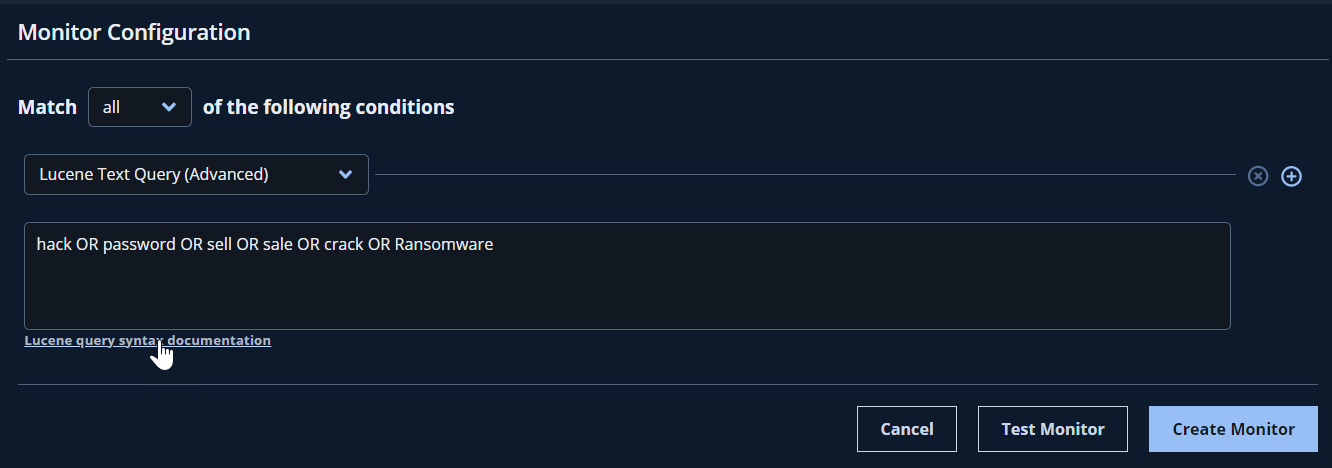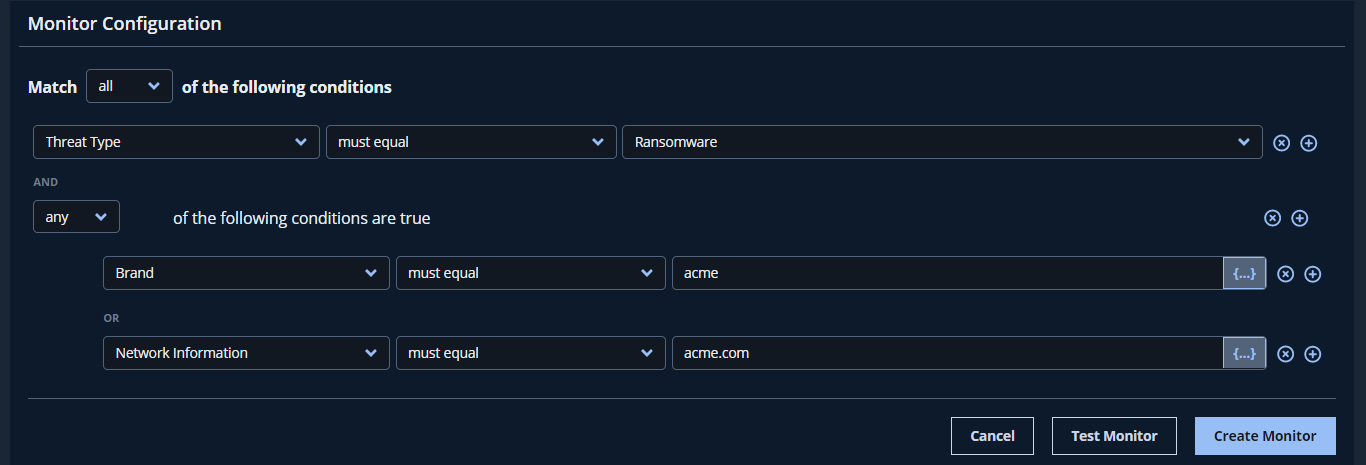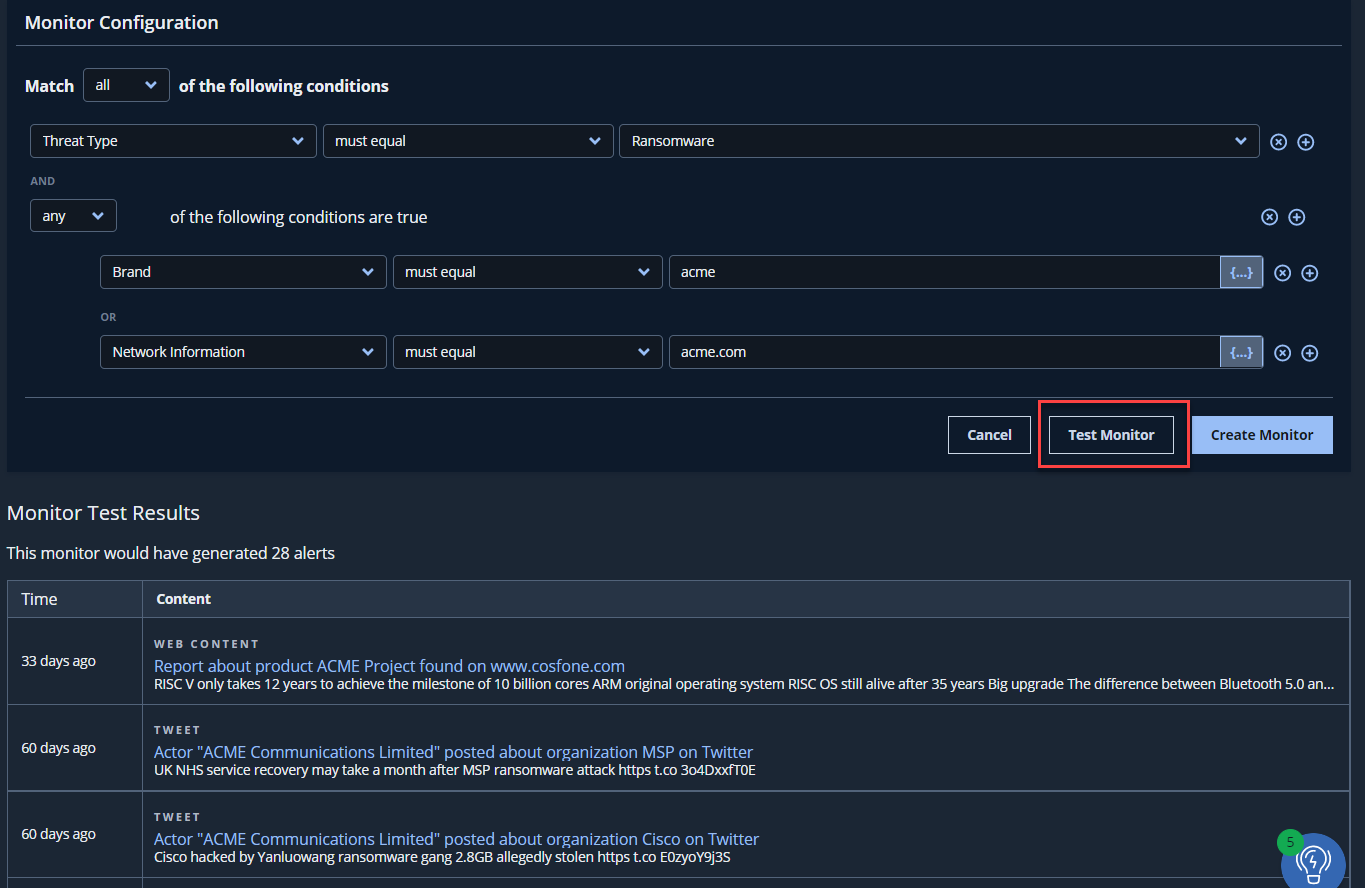Build Effective Monitors
Build Effective Monitors | Docs
ExcerptAn effective monitor in Digital Threat Monitoring (DTM) is one that targets the content that’s relevant to your needs, while minimizing the amount of false-positives (noise). To build effective monitors, we recommend that you first explore existing data using Research Tools to understand the types of content your target data includes. With that background, you can create the first version of your monitor and then update based on the alerts that are generated.
An effective monitor in Digital Threat Monitoring (DTM) is one that targets the content that’s relevant to your needs, while minimizing the amount of false-positives (noise). To build effective monitors, we recommend that you first explore existing data using Research Tools to understand the types of content your target data includes. With that background, you can create the first version of your monitor and then update based on the alerts that are generated.
Each DTM Monitor Condition consists of the following:
-
A Topic (Select Type) that defines the set of things you would like to query for the Condition. Most of these topics are groups of entities or labels that have been extracted from the document and transformed. The two exceptions to this are the
Free Text SearchandLucene Text Query (Advanced)topics which are covered in Text Matching Topics. -
A Condition Operator such as
must equalormust contain, which defines the operation to apply when searching for your Condition's values in the document. -
The Condition Values (comma-separated terms or lists of terms), which are one or more values that you want to match in the document, entities, or labels. If you specify more than one value, the values in a given Condition are combined using the
ORoperator. That is, only one of the values must match.Values are normalized before matching, and are therefore not case sensitive.
-
Each group of DTM Monitor Conditions in a Monitor is also governed by its Conjunction which can either be:
all: All conditions within the group must be true.any: Any one of the conditions within the group must be true.

For example, the simple Monitor Conditions in the following screenshot will generate an alert when an ingested document contains a Bank Identification Number (detected entity) that contains 111111 or 222222 AND that same document has a Brand (detected entity) that equals myorganization.
Given that Condition values are normalized, myorganization will also match with MyOrganization and MYORganization, for example.

Monitors can be as broad or as targeted as you want them to be, using monitor topic conditions and text query strings. Use text query strings to create a broad search and use a monitor topic condition to target specific types and values. For example, suppose you're interested in Malware threats against the Nike athletic apparel company. There are two ways to approach the search:
Broad:
- Use a monitor topic condition for
Threat Type must equal Malware. This condition ensures that your ML pipeline has identified a Malware classification in the document. - Use a text query string for
nike.
Targeted:
- Use a monitor topic condition for
Threat Type must equal Malware. This condition ensures that your ML pipeline has identified a Malware classification in the document. - Use a monitor topic condition for
Product or Brand Name must equal nike. This condition ensures that your ML pipeline has identified a product of typenike.
While the broad approach produce matches for documents mentioning the Nike company, it will also potentially match on any mention of the word nike. For example, a document regarding Malware with the author Jane Nike would be included in the results, which may not be relevant resulting in a noisy monitor.
Text Matching Topics
The Free Text Search and Lucene Text Query (Advanced) topics let you match on text within the document in any arbitrary property. Usage of these topics should be treated with care, since they are effectively "grepping" the document text rather than being applied to identified entities or labels.
Free Text Search
The Free Text Search topic lets you specify one or more values which are then treated as keywords to find within the document. For example, using a Free Text Search Condition with must contain and the values root and access would match on any of the following: root, rooted, root-access, noaccess,theroot.com, [email protected]. While this outcome may be desirable in some scenarios, this technique can provide matches that are very broad and result in a noisy monitor without careful usage.
Lucene Text Query
In addition to matching Monitor Conditions, your monitors can (optionally) further search documents using a text query string as well. In this usage, the Lucene Text Query becomes part of your Monitor Conditions used to match documents as they are ingested. A query string is an Elasticsearch Query String (Lucene-based) that lets you:
- Perform a free text search over the entire document contents.
- Search specific document model fields using a JSON path-based syntax, for example
tweet_hashtags.hashtag:ransomware. - Use wildcards and shallow forms of regexes.
- Build queries using the basic syntax supported by Elasticsearch Query String syntax, including operators such as
AND&OR.
If any of the terms you're searching for include any special characters such as periods, commas, or dashes, the term should be enclosed in double quotes. For example rather than acme.com you should use "acme.com" , rather than using i-sight use "i-sight".
If specified, the query string is matched only after your monitor topic conditions have matched. In other words, it's a way to refine your search further once your topic conditions have been met.

Document Model Search Paths
Using a text query string lets you query specific model paths of your documents. Targeting specific paths in the model can be useful to target very specific values in the document. However, all text paths in documents can be searched without specifying model search paths. For example, if you use a text query string of hack OR password both hack and password will be searched for in all text paths of documents.
When specifying model search paths in the query string, the format is a dotted notation where each value in the path is the property name in the document. For example, if you want to search for a specific hashtag value in a tweet document, the following path can be used: tweet_hashtags.hashtag, which specifies the document path to search is the hashtag property of the tweet_hashtags object in a tweet document.
To understand which paths exist, you must look at the Schemas in the API specification (see Monitor fields documentation). There you will find the document types that correspond to the models. The following top-level models are currently being supported in DTM:
document_analysisdomain_discoveryemail_analysisforum_postmessagepasteshop_listingtweetweb_content_publish
When using document model paths in your query string, ensure that your monitor topic conditions are that set up to only match on the respective document type. For example, to search on the content of Forum Posts, you would add a Monitor topic condition Search Collection Type``must equal``forum_post . This ensures that when your query string is used to search the document, results will always be of type forum_post.
Example Monitors
Filenames
Suppose you want your Monitor to alert anytime a document mentions the filename my_sensitive_file1 or my_sensistive_file2. The following Monitor Conditions depict how you might approach defining this Monitor. Notice that the conjunction used is any, so either of the Conditions can match in order to return a result. Both the Filenames & Paths and the Network Information topics are used here because the filenames could be detected as a file system path, or in the path of a URL. This Monitor Configuration captures either of those scenarios.

Email Addresses
Finding email address leaks can be easily accomplished using a Monitor with a single condition. As shown in the Monitor fields documentation, email addresses are searched using the Person or Identity topic. If you want to match on any email addresses that contain your email domain (say mydomain.com), you can simply check this topic for any values that end with @mydomain.com. This will cover any usernames within the domain. If you wanted to alert on specific user email addresses, you could instead use the must equal operator and then provide a list of the full email addresses you want to target.

IP Addresses
Suppose you want to alert on any content that mentions an IP address in your internal networks within your two CIDR blocks 131.11.10.0/18 and 131.11.9.0/18. You can accomplish this by simply using the CIDR block notation in a Network Information Topic Condition as shown in the following screenshot. DTM understands CIDR blocks and can ensure it matches anytime an IP address is found within the given CIDRs.

Target A Group Of Users
Your organization was recently attacked and while investigating this attack you’ve identified the following list of internet handles as being involved in the attack: hackerz, cobrax, zerod, insideatk. You want to create a monitor that will alert you of any new information that may be related to any of these handles.
This monitor is very simple; it's a single Person or Identity must equal condition with the list of handles to match on as shown in the following screenshot:

Target Ransomware for Organization or Domain
You want to be alerted for potential Ransomware associated with your organization acme or your domain acme.com.
This is another simple monitor that uses a nested condition group to search for the organization acme or the domain acme.com when identified a Threat Type of Ransomware:

Track posts by a specific author on a specific forum
You want to follow any forum post created by the internet handle darkrx on the forum site called secretprojects.co
Since you only want to target forum posts by a specific author, and on a specific forum site, you need to leverage the document path syntax in your text query string author.identity.name:darkrx AND forum.name:secretprojects.co as shown in the following screenshot:

Track Contents Posted by Specific Handle Names in the Deep and Dark Web
You want to track contents posted by specific handle names in the deep and dark web. Here you can use Lucene to target author specific fields of documents with the following query:
author.identity.name:(Entropy PwnSec) OR sender.identity.name:(Entropy PwnSec) OR sender.telegram.name:(Entropy PwnSec) OR seller.identity.name:(Entropy PwnSec)This query includes all author-related JSON paths for the document types that you're targeting by setting the Search Collection Type to the appropriate document types. It will match when any of those author paths include either of your actor/handle names. The final monitor configured is shown in the following screenshot:

Watch Forum Posts of IP Addresses in a Network Segment
You have reason to believe one or more of your public-facing services/hosts has been compromised on your public-facing network. For demonstration purposes we'll use the non-routable network 10.9.4.0/24. You want to create a monitor to watch all Forum Posts for any mentions of IP addresses in that network segment.
This is another simple monitor that leverages the ability to specify a network CIDR as an IPv4 address as shown in the following screenshot. Any IP address in the specified CIDR will trigger a match.

Testing a Monitor
Once you create a monitor, you can test by selecting the Test Monitor button.

A few caveats while testing a monitor: The must contain & must not contain may not work correctly using this feature. Test queries are limited to 200 monitors.
Updated about 24 hours ago